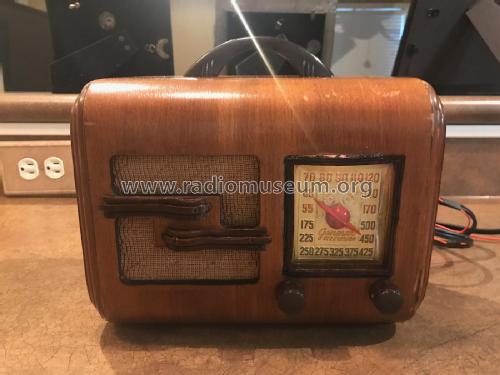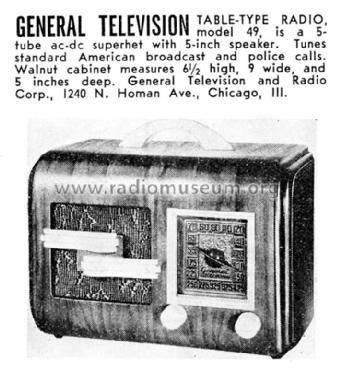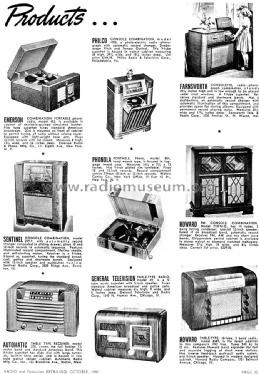- Land
- USA
- Hersteller / Marke
- General Television and Radio Corp.; Chicago, IL
- Jahr
- 1941/1942
- Kategorie
- Rundfunkempfänger (Radio - oder Tuner nach WW2)
- Radiomuseum.org ID
- 212700
-
- Marke: General
Klicken Sie auf den Schaltplanausschnitt, um diesen kostenlos als Dokument anzufordern.
- Anzahl Röhren
- 5
- Hauptprinzip
- Superhet allgemein; ZF/IF 456 kHz
- Anzahl Kreise
- 6 Kreis(e) AM
- Wellenbereiche
- Mittelwelle, keine anderen.
- Betriebsart / Volt
- Allstromgerät / 110 - 120 Volt
- Lautsprecher
- Dynamischer LS, Prinzip (Edyn oder Pdyn) nicht gegeben.
- Material
- Gerät mit Holzgehäuse
- von Radiomuseum.org
- Modell: 49 L49 - General Television and Radio
- Form
- Tischgerät ohne Drucktasten, bis 35 cm Breite (Kleingerät, meist dekorativ. Nur für Netzbetrieb, doch Transportgriff möglich).
- Bemerkung
- Speaker: both versions with or w/o field coil possible. Also with or w/o handle. Ivory trim.
- Datenherkunft
- Table Top Radios Vol. 4 Stein 2003
- Literaturnachweis
- Collector's Guide to Antique Radios (7th Edition)
- Literatur/Schema (1)
- Rider's Perpetual, Volume 18 = covering late 1947 to early 1948 (14-1)
- Autor
- Modellseite von Hans-Joachim Korn † 16.11.15 angelegt. Siehe bei "Änderungsvorschlag" für weitere Mitarbeit.
- Weitere Modelle
-
Hier finden Sie 106 Modelle, davon 47 mit Bildern und 70 mit Schaltbildern.
Alle gelisteten Radios usw. von General Television and Radio Corp.; Chicago, IL
Sammlungen
Das Modell 49 L49 befindet sich in den Sammlungen folgender Mitglieder.
Forumsbeiträge zum Modell: General Television: 49 L49
Threads: 1 | Posts: 3
This is the 1st 3-wire power cord antique radio that I have come across that I am in the process of restoring.
I need to replaced the crumbling power cord and see that it has 3 wires. One live wire goes to the T1 antenna connection. One live wire goes to the on/off volume switch and the 3rd wire connects to the 35Z5GT Half-Wave Vacuum Rectifier Power-supply tube, however the other end of this wire does not make a connection at the plug itself.
I am confused! I would think this might be a resistance wire (R1 - 10 ohm)?
I don't understand how this works if the end is not connected to something at the plug end.
Greg Rowland, 05.Jan.24



